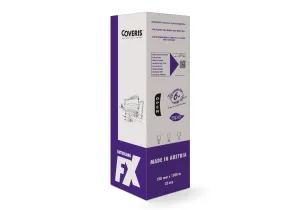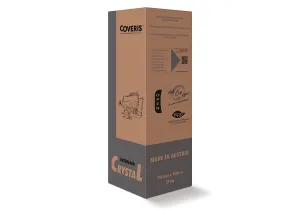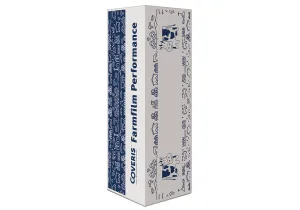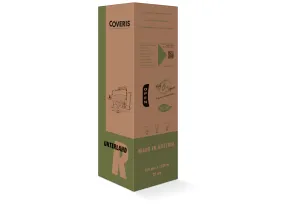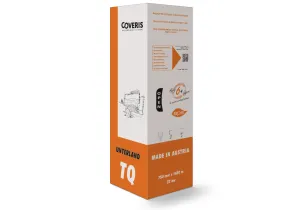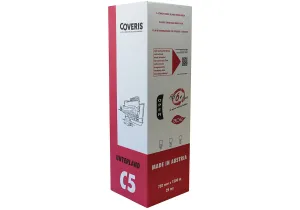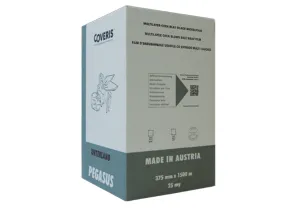High Performance Silage Films
Under its well-established brands Unterland and Farmfilm, Coveris provides high quality silage films with worldwide shipping. The films offer many benefits that meet special regional requirements, such as high UV and bird damage protection, easier handling, simplified waste disposal, higher recycling value and are available in different colours. Find out more below.

Technical Support
Technical FAQ
Look for a well known brand, that has got a high adhesion force combined with good seal properties. Do not make price per roll your main argument, as normally you get the quality you pay for.
All the colors used by us are designed in the same way, a carrier material with Pigments. All colors behave in the same way during wrapping.
The difference between the colors gets visible when the bales are wrapped. The darker a film is the stronger is its influence on the bale. A darker film heats up more than a light colored one, the outer layers of the silage get
cooked.
The sugar starts to caramelize, the cooked silage looses much of it nutritional value, the cattle needs more silage to bring the same performance.
We recommend white films that nearly do not heat up to protect the silage and keep high nutrition value.
Count the number of revolutions till the bale is covered with film, now add 1 and then double the number of revolutions, you now have 4 layers. For 6 layers just increase the number by 50%
A silage up to 50% dry matter requires 4 layers of film as minimum, we recommend 6 layers if you have more than 50% dry matter you should use at least 6 layers, the same is for square bales and coarse silage.
Generally no, haylage has not enough humidity to start any fermentation, the high dry matter stops any fermentation and the durability of the silage, mould and rottenness will start. Only with very special treatment such bales are possible. Please inform yourself before in detail.
The bales should be stored their flat side, because here the number of layers of film is higher. You also have the possibility to store up to three layers high.
Don`t store bales that show no good stabile shape in more layers. Between the bales you should leave at least one hand, because when the bales touch each other the possibility for the growth of mould is higher.
If possible cover the bales with a net against birds and with a fence against wild animals or cattle.
Coveris Agri Stretch is stabilized for one year of exterior storage. This means that the bales are protected against the Sun Rays for one year, if you store them on a suitable place, which has not too much hours of sunshine a day, the bales can be stored longer.
Cover the holes immediately, the best would be a repair adhesive tape. It would also be good to use the bales as soon as possible because entering of oxygen starts the growth of mould.
An originally packed roll can be stored for 1 years at least, but there are important points you should take care of:
Store the rolls standing like you have received them on the pallet in the original box.
Temperatures lower than the freezing point are without consequences but don`t store the rolls at extremely high temperatures as this has influence on the tackiness. Keep the rolls inside the box as sun light destroys the UVstabilization system.
When temperatures are very high, more glue migrates to the surface of the film than with lower temperatures. This glue can remain at the pre-stretch roll where it works like a slip layer. In this case the film slips through the rolls and does not get stretched by them.
It is necessary then to clean the rolls with paraffin or diesel, because these fluids do not harm the film.
Round bales with normal silage should be wrapped with a pre-stretch of about 70%, if the dry matter contents are very high, it is better to switch to 55%. When you do square bales we recommend also a pre-stretch of 55%, because the edges of the bales are a high strain for the film.
The pre-stretch of the wrapper should be checked regularly, to obtain the best results. For this check make to lines on the roll with a distance of 10 cm between each other, then wrap one turn so that the film gets stretched. Now measure the distance between the two lines.
- 15 to 16 cm → 50 to 60% pre-stretch
- 17 to 18 cm → 70 to 80% pre-stretch
- More than 18 cm → over 80% pre-stretch too much for silage use
When you wrap a round bale (120cm diameter, 120cm length), you will receive the following amount of bales:
750 mm Film with 1.500 m
70 % Pre-Stretch
6 Layers: 20 to 21 Bales
8 Layers: 15 to 16 Bales
750 mm Film with 1.500 m
55 % Pre-Stretch
6 Layers: 18 to 19 Bales
8 Layers: 14 to 15 Bales
500 mm Film with 1.800 m
70 % Pre-Stretch
6 Layers: 17 to 18 Bales
8 Layers: 13 to 14 Bales
500 mm Film with 1.800 m
55 % Pre-Stretch
6 Layers: 15 to 16 Bales
8 Layers: 11 to 12 Bales
WHEN YOU WRAP A SQUARE BALE (120CM X70 CM X 150CM) YOU NORMALLY GET THE FOLLOWING AMOUNTS OF BALES. AT A SQUARE BALE YOU SHOULD ONLY HAVE 55% PRE-STRETCH.
500 mm Film with 1.800 m
55 % Pre-Stretch
4 Layers: 16 to 17 Bales
6 Layers: 11 to 12 Bales
750 mm Film with 1.500 m
55 % Pre-Stretch
4 Layers: 20 to 21 Bales
6 Layers: 14 to 15 Bales


